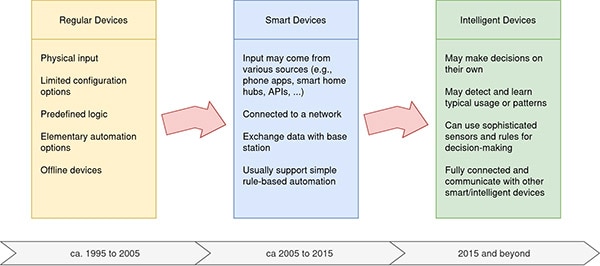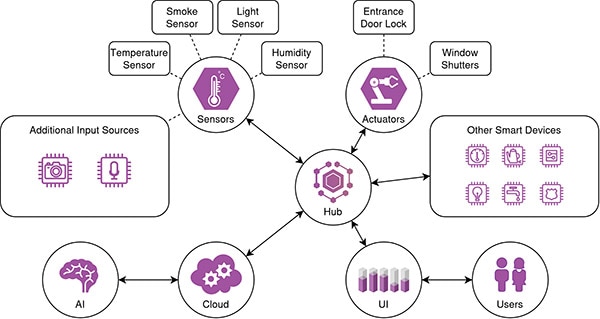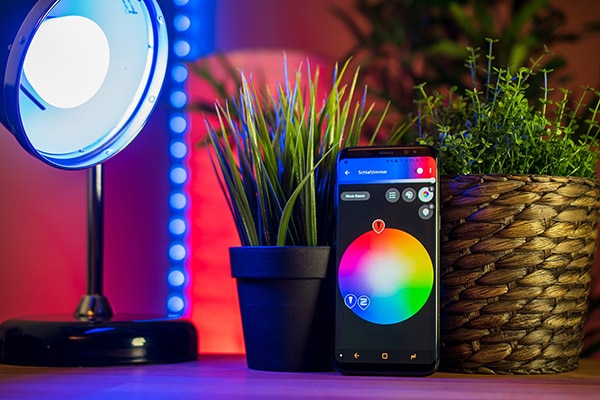A Summary of Smart Home Concepts and Terms
2023-02-20 | By Maker.io Staff
Smart home devices offer users great flexibility in controlling virtually any aspect of their homes, from setting up an automated light control schedule to opening and closing curtains without getting up. For makers, smart home devices offer a plethora of intriguing project opportunities for building new smart equipment and remotely controlling existing devices in their homes.
However, for beginners, the vast world of existing smart home SDKs, terminology, and technologies can be overwhelming and pose a seemingly insurmountable barrier to entry. This article covers some of the most important terms and concepts in smart home technology so that you can get started with building your own smart equipment in practically no time!
Levels of Smart Home Terminology Explained
Smart homes are not a new concept. Instead, the idea of automating devices in one’s home goes back decades. However, realistically, smart home technologies first reached functional mainstream status in the late nineties to early 2000s. Back then, devices were primitive and usually not connected to a local wireless network or the Internet. In that sense, the term ‘smart’ should be used carefully from today’s point of view.
These first mainstream devices were practical helpers, such as timed lightbulbs that could turn off after a specific (typically pre-programmed) number of hours. In addition, users could sometimes change the device’s behavior by power-cycling the device a certain number of times.
As wireless technologies matured and reached mainstream status, manufacturers and tinkerers started incorporating more complex controls into everyday electronics. As a result, the market evolved into what we would describe as smart devices today. These can be simple things such as wireless power sockets with built-in meters and lightbulbs that users can control using a mobile app to intelligent kitchen appliances (for example, a fridge that can monitor the freshness of its contents).
 This image shows the rough revolution of smart home technology as devices matured from simple direct input to decision-based systems.
This image shows the rough revolution of smart home technology as devices matured from simple direct input to decision-based systems.
More advanced devices blur the line between a smart home and an intelligent home – a distinction worth delving into a bit more. A smart home can be controlled by users remotely. It typically also allows them to define simple rule-based behavior (for example, turning on the lights after 8 PM). An intelligent home, however, can provide features beyond these simple functions, such as making decisions based on previously learned patterns and collected data. Home automation sits somewhere between these two concepts and lets users define more elaborate rules to automate the devices in their home, like turning on specific lights only when it’s dark outside and only in winter. These features require sensors and additional data, such as weather information, to function correctly.
Components of Smart Home Systems
Smart home systems come in all shapes and colors. They can be as simple as a single connected lightbulb that users can directly access via their smartphone or as elaborate as a control center that lets operators precisely control various settings of a whole industrial complex.
Most smart home systems today comprise multiple connected devices that can communicate with each other. These kinds of systems typically require some base station, or hub, to orchestrate the devices in the local network. While it’s not entirely necessary, a hub makes the life of its users much more straightforward, as it allows controlling multiple devices at once without switching apps.
 This figure illustrates the main components of a typical smart home system and examples of devices in each category.
This figure illustrates the main components of a typical smart home system and examples of devices in each category.
The hub typically provides a graphical user interface that makes interacting with the system easy. Some allow the use of dedicated remote controls that contain a few physical buttons and are simpler to use than a full-fledged web UI. A smart home system can also have dedicated human-machine interfaces (HMIs), like a tablet installed on a wall that lets users control the lighting in a room. These HMIs only display the hub’s user interface and allow users to change settings. Besides a graphical UI, some hubs also accept other means of input, such as voice commands.
Finally, a typical system contains additional sensors and actuators that are not classified as “smart appliances.” Sensors can determine various environmental conditions (like the brightness in a room) and communicate their readings with the base station, which can then activate or deactivate the lights in a room.
Finally, the base station can communicate with external web services, such as a device manufacturer's cloud API, to collect and process data. These services can provide additional features (like AI-enhanced pattern recognition) that let the system learn user behavior and preferences.
Challenges to Overcome when Designing Smart Home Systems
From a maker’s perspective, a few challenges are difficult to overcome when designing a smart home system. First, many different manufacturers provide intelligent devices, and they often use competing standards that are incompatible. Therefore, the base station should, ideally, be able to work with components made by many different vendors. In addition, it should offer support for the most-used communication standards and protocols, such as WiFi, BLE, and various mesh networks.
Ideally, the system should also remain useful even without an active internet connection. Therefore, local processing power is required to keep the system operational and safe, even with an unreliable or broken internet connection. In that context, many users don’t want to share their private data with large corporations due to privacy and security concerns. Finally, manufacturers may take their online services offline at any time, so the devices and system should still function in a few years if they decide to deprecate their cloud-based services.
Moreover, optimizing the battery life and overall power consumption of each device and the entire system is also necessary, as a smart home system will typically operate 24/7, and daily battery changes are not a viable option for most users.
Summary

Smart home and automation systems offer users great flexibility in managing the comfort around their homes. A typical consumer-grade system comprises multiple connected, intelligent devices that a base station orchestrates. This central hub may or may not upload data to the cloud for further processing, but it should still be helpful if the internet connection is slow, spotty, or offline. Next, modern smart home systems also contain multiple sensors that allow more complex automation settings.
Connectivity, vendor-specific hardware, security, overall power consumption, and battery life are the most significant challenges to overcome when designing a smart home system. Luckily, makers can choose from a range of easy-to-use SDKs and hardware for these tasks, which are discussed in the following article.
Stay tuned for future articles that will build on these concepts and show you how to start making steps toward your own smart devices in your home!
Have questions or comments? Continue the conversation on TechForum, DigiKey's online community and technical resource.







 中国
中国